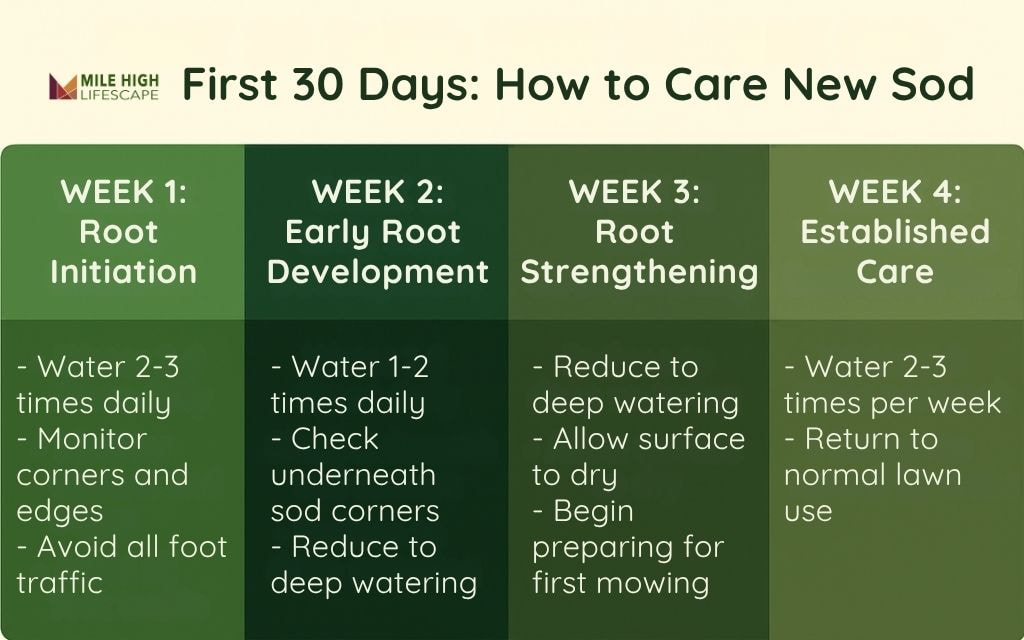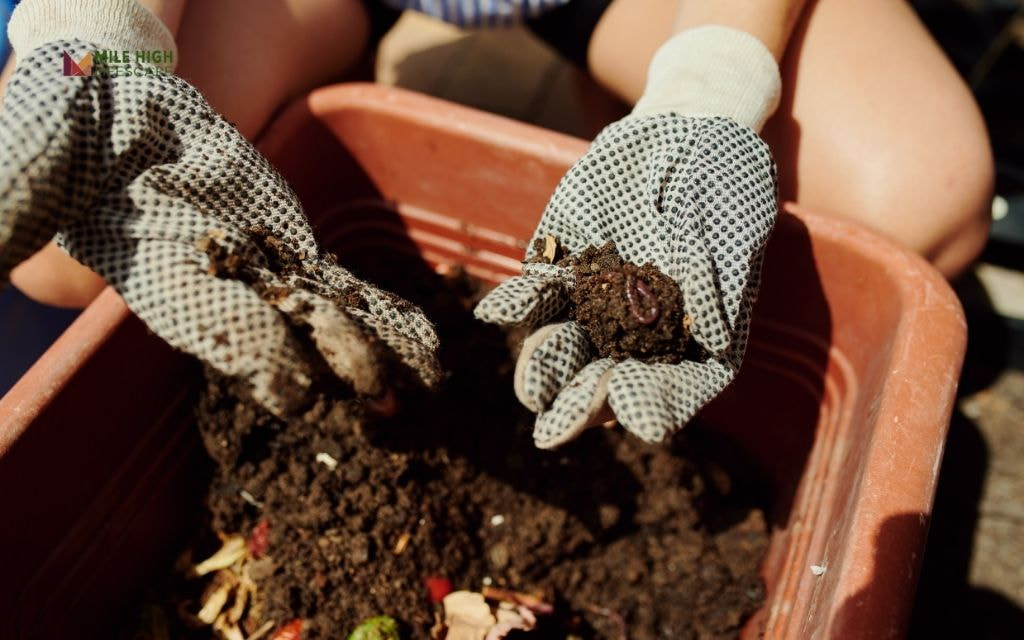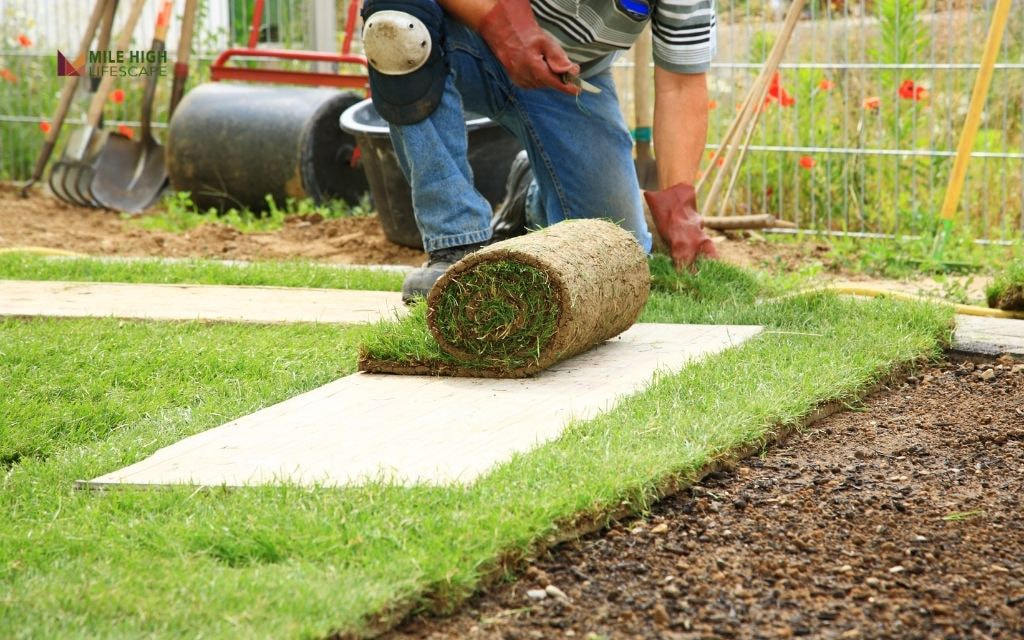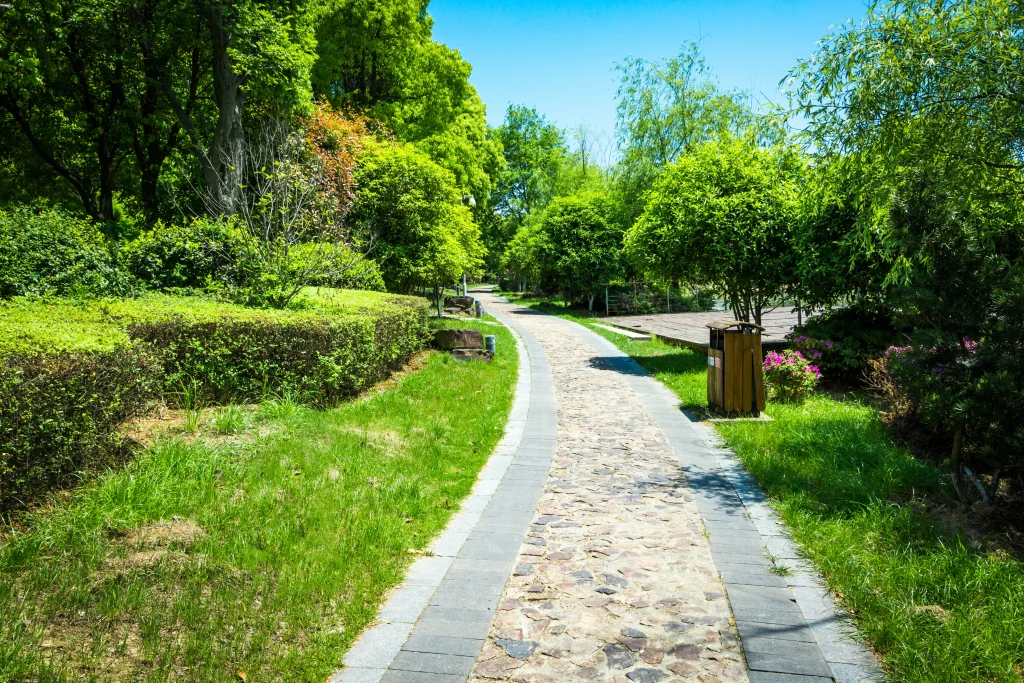How to care for new sod? To take care of healthy new sod, maintain consistent moisture during the first few weeks, then transition to a deep, infrequent watering schedule as roots develop.
Sod provides an immediate lawn solution for Denver properties, delivering instant curb appeal and effective erosion control without the wait of seed germination. However, Denver’s unique growing conditions – high altitude, semi-arid climate, and intense sun exposure – create specific challenges for new sod establishment.
At Mile High Lifescape, we understand the success of your new sod depends almost entirely on proper aftercare, especially during the critical first month. Without appropriate attention during this establishment period, even perfectly installed sod can struggle to thrive.
How to Care for New Sod? First 30 Days
Understanding the week-by-week needs of your new sod in Denver’s climate helps ensure successful establishment:
Week 1: Root Initiation
- Water 2-3 times daily (morning, midday, late afternoon)
- Keep sod consistently moist but never soggy
- Monitor corners and edges which dry faster
- Avoid all foot traffic
Week 2: Early Root Development
- Water 1-2 times daily, preferably before 9 AM
- Check underneath sod corners to verify root development
- c completely
Week 3: Root Strengthening
- Reduce to deep watering every other day
- Begin preparing for first mowing when grass reaches 3-4 inches
- Allow surface to dry slightly between waterings
Week 4: Transition to Established Care
- Water deeply 2-3 times per week
- First mowing may occur if roots have adequately established
- Begin gradual return to normal lawn use
By day 30, your sod should show signs of strong root establishment. The lawn will require less frequent watering, though Denver’s climate demands continued attention to moisture levels.

Here a more detailed timeline for your first month of your sod:
| Time Period | Watering Requirements | Lawn Care Activities | Root Development | Denver-Specific Considerations |
| Day 1 | Water immediately after installation until soil is saturated (30-45 minutes per zone) | Avoid all foot traffic | No root development yet | Apply extra water to edges and corners which dry faster in Denver’s low humidity |
| Days 2-7 | Water 3x daily (early morning, midday, late afternoon) for 15-20 minutes per zone | Keep pets and people completely off the lawn | Root initiation begins | Increase to 4x daily if temperatures exceed 90°F or during high wind conditions |
| Days 8-14 | Reduce to 2x daily (morning and late afternoon) for 20 minutes per zone | Continue restricting all foot traffic | Shallow roots begin forming; should resist gentle tugging | Monitor during sudden temperature changes common in Denver spring/fall |
| Days 15-21 | Transition to 1x daily (morning) for 25-30 minutes per zone | Prepare for first mowing when grass reaches 3.5-4 inches | Roots extend deeper into soil | Adjust timing if Denver water restrictions apply; water before 10 AM |
| Days 22-30 | Deep watering every other day for 30-35 minutes per zone | First mowing with sharp blades at 3-inch height; minimal foot traffic allowed | Root system strengthens and expands | Begin testing soil moisture levels with screwdriver test before watering |
| After Day 30 | 2-3x weekly deep watering (about 1 inch total) | Resume regular mowing schedule; apply first fertilizer | Root system continues developing | Adjust to Denver’s seasonal needs; more frequent in summer, less in spring/fall |
1. Watering New Sod
Watering new sod stands as the most crucial factor for successful sod establishment in Denver’s challenging climate:
- First Week: Water enough to keep the sod and underlying soil consistently moist – about 15-20 minutes per zone, 2-3 times daily.
- Optimal Timing: Water before 9 AM to minimize evaporation and fungal disease risk. If temperatures exceed 90°F, add an evening watering after 6 PM.
- Check Moisture Levels: Lift corners of sod periodically to verify moisture has penetrated the soil beneath. The soil should feel damp but not waterlogged.
- Adjust for Weather: Increase frequency during hot, windy days and reduce during cool, overcast periods.
- Watch for Signs: Sod that shows shrinkage between pieces or develops a grayish-blue color needs immediate water.
2. Mowing New Sod
Proper mowing new sod practices help strengthen your new sod while avoiding damage to developing root systems:
- Wait until grass reaches 3-4 inches tall (typically 10-14 days after installation)
- Ensure the sod has rooted sufficiently – test by gently tugging; resistance indicates rooting
- Mow when the lawn is dry to prevent clumping and root damage
- Sharpen mower blades before cutting new sod to ensure clean cuts
- Set mower height to remove no more than ⅓ of the grass blade length (about 2.5-3 inches)
- For the first mowing, consider using a walk-behind mower rather than heavy riding equipment
- Mow early morning or evening to avoid Denver’s midday heat stress
- Leave clippings on the lawn to return nutrients to the soil unless they form clumps
A common mistake involves mowing too soon or cutting too short. Both practices stress the developing root system and can significantly set back establishment in Denver.
3. Fertilizing New Sod
Learning how to fertilize new sod strategically helps sod develop strong roots and drought tolerance in Denver’s challenging environment:
- Wait 3-4 weeks after installation before applying any fertilizer
- Select a starter fertilizer with higher phosphorus content to encourage root development
- Apply in early morning or just before watering to minimize burn risk
- Use approximately 1 pound of nitrogen per 1,000 square feet
- Distribute fertilizer evenly using a broadcast spreader
- Water lightly after application to activate the fertilizer and move it into the root zone
Denver’s native soils often lack essential nutrients and organic matter. However, over-fertilizing new sod creates more problems than it solves. A soil test provides the most accurate guidance for your specific property’s needs. Once established, your lawn will benefit from a regular fertilization program 3-4 times annually, with emphasis on fall applications for winter hardiness.

4. Traffic Control: Keeping Off the Grass
Limiting traffic on new sod proves essential for proper root establishment:
- Keep foot traffic completely off new sod for the first 2-3 weeks. During this period, the roots remain shallow and vulnerable to disruption. Even light traffic can prevent proper root-to-soil contact and create depressions where water may pool.
- The edges of newly installed sod deserve particular attention as they dry out faster and have less stability. Consider placing temporary stepping stones if access is necessary across lawn areas.
- For families with children or pets, establish clear boundaries with temporary fencing or visual markers.
- Inform all household members, maintenance staff, and service providers about the restricted areas.
After the initial establishment period, gradually reintroduce normal use patterns rather than immediately resuming heavy activity.
Learn how to keep pets off your sod in this guide can help improve your grass health.
Common Sod Care Mistakes to Avoid in Denver
Prevent these frequent mistakes to ensure your new sod thrives:
- Inconsistent Watering: Allowing sod to dry out between waterings during the establishment phase prevents proper root development.
- Improper Mowing Height: Cutting new sod too short stresses the grass and reduces drought tolerance.
- Premature Foot Traffic: Walking on new sod before adequate root establishment disrupts soil contact and creates uneven surfaces.
- Neglecting Soil Preparation: Failing to address Denver’s native clay soil issues before installation limits long-term success.
- Inadequate Fall Care: Overlooking late-season watering and fertilization reduces winter hardiness in Denver.
- Improper Fertilization Timing: Applying fertilizer too soon or using the wrong formulation can burn new roots and waste resources.
- Ignoring Weather Conditions: Failing to adjust care practices during heat waves, cold snaps, or precipitation events.
The most pervasive mistake remains underestimating Denver’s unique climate challenges. Techniques that work in more humid regions often fail here without adaptation.

Conclusion
Successfully establishing new sod in Denver requires attention to proper watering, appropriate mowing practices, strategic fertilization, and patience during the root development phase.
The effort invested during these first weeks creates the foundation for a drought-resistant, durable lawn that enhances your property for years.
With Denver’s challenging growing conditions, professional guidance often proves invaluable. Mile High Lifescape specializes in installing and maintaining healthy lawns throughout the Denver metro area. Our experienced team understands the specific challenges of our region and can provide customized care recommendations for your property’s unique conditions.
For new sod maintenance, or other lawn care, landscaping services, contact Mile High Lifescape at (303) 877-9091 for a free consultation today!
Frequently Asked Questions (FAQs)
How do you care for freshly laid sod?
Keep freshly laid sod consistently moist by watering 2-3 times daily during the first week. Water enough to penetrate the sod and top two inches of soil beneath. Minimize all foot traffic, monitor for even moisture distribution, and begin reducing watering frequency after 7-10 days as roots establish.
What should you not do with new sod?
Never allow new sod to dry out completely, walk on it during the first two weeks, mow too early or too short, apply fertilizer immediately after installation, or ignore signs of stress such as shrinkage between pieces or discoloration.
How often should you water new sod?
Water new sod 2-3 times daily during the first week. In Denver’s climate, this typically means morning, midday, and late afternoon watering sessions of approximately 15-20 minutes each. Reduce to once daily in week two, then transition to every other day in week three as roots establish.
Are you supposed to walk on new sod?
No, avoid walking on new sod for at least 14 days. Foot traffic disrupts root-to-soil contact during the critical establishment period. The developing roots remain shallow and vulnerable to damage, potentially creating permanent depressions or uneven areas in your lawn.
How long until sod takes root?
Sod begins developing shallow roots within 10-14 days after installation. Complete establishment, including deeper root development, typically requires 4-6 weeks during the growing season in Denver. Fall installations may take longer due to cooling temperatures, while summer installations require extra attention to moisture levels.
